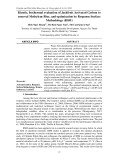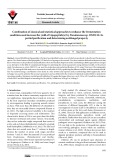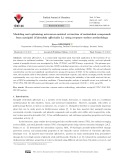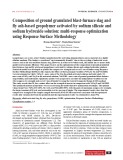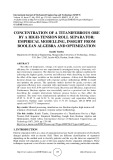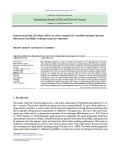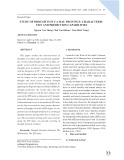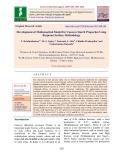
RSM model
-
The aim of this research is to investigate the effect of extrusion condition on the physical and function properties of soybean crud residue (SCR) base floating fish feed. Response surface methodology (RSM) a collection of a Statistical techniques use for experimental design, model development, evaluating impact and effect of factors on responses, optimization of factors condition and level desirability was used to assess the aim and objectives of this research work.
 15p
15p  viisac
viisac
 23-09-2023
23-09-2023
 3
3
 1
1
 Download
Download
-
Waste from Jackfruit has little economic value and often causes serious environmental problems. The conversion of jackfruit waste will help reduce waste treatment costs, provide a potential source of raw materials for the activated carbon (AC) and increase economic value. In this study, the ACs from the Jackfruit shell and pulp were synthesized by microwave assistance for removing organic dyes.
 13p
13p  vidoctorstrange
vidoctorstrange
 06-05-2023
06-05-2023
 9
9
 2
2
 Download
Download
-
Around 200 different lipopeptides (LPs) have been identified to date, most of which are produced via Bacillus and Pseudomonas species. The clinical nature of the lipopeptide (LP) has led to a big surge in its research. They show antimicrobial and antitumor activities due to which mass-scale production and purification of LPs are beneficial. Response surface methodology (RSM) approach has emerged as an alternative in the field of computational biology for optimizing the reaction parameters using statistical models. In the present study, Pseudomonas sp.
 16p
16p  langthannam
langthannam
 29-12-2021
29-12-2021
 10
10
 0
0
 Download
Download
-
Calendula officinalis L. is a commercially important plant that finds application in the treatment of various diseases in traditional medicine. The total antioxidant capacity, radical scavenging activity, and total phenolic content of marigold extracts were investigated by Folin, CUPRAC, and DPPH assays, respectively. The optimum operating conditions of microwave-assisted extraction (MAE) including temperature, extraction time, solvent-to-solid ratio, and solvent concentration were ascertained by employing response surface methodology (RSM).
 15p
15p  tudichquannguyet
tudichquannguyet
 29-11-2021
29-11-2021
 13
13
 0
0
 Download
Download
-
Usnic acid (UA) was extracted from Usnea longissima (L.) Ach. in supercritical carbon dioxide (SC-CO2 ) medium. The selected process parameters were extraction temperature (35–45 °C), amount of co-solvent (0%–5%) and extraction time (5–9 h). These parameters were applied to Box-Behnken design (BBD) belonging to response surface methodology (RSM) to determine optimum process parameters for the highest amount of UA in the extract. g UA/100g lichen, extraction yield % and UA content values were calculated in the range of 0.045–0.317, 2.77–5.
 9p
9p  tudichquannguyet
tudichquannguyet
 29-11-2021
29-11-2021
 5
5
 0
0
 Download
Download
-
This paper focuses on the optimization of the composition of ground granulated blast-furnace slag and fly ash-based geopolymers activated by sodium silicate and sodium hydroxide solutions. Statistical models are developed to predict the compressive strength and cost of 1 ton of binder using Response Surface Methodology (RSM).
 9p
9p  nat_qb73
nat_qb73
 21-02-2021
21-02-2021
 19
19
 2
2
 Download
Download
-
In the wire arc additive manufacturing (WAAM) process, the geometry of single welding beads has significant effects on the stability process and the final quality and shape of manufactured parts. In this paper, the geometry of single welding beads of 308L stainless steel was predicted as functions of process parameters (i.e. welding current I, voltage U, and travel speed v) by using the response surface methodology (RSM). A set of experimental runs was carried out by using the Box-Behnken design method.
 13p
13p  kequaidan6
kequaidan6
 11-07-2020
11-07-2020
 38
38
 2
2
 Download
Download
-
The objective was to determine the optimal conditions for achieving the highest grade, recovery and efficiency while describing in clear terms the effect of the input variables on the studied responses. A three-level Box-Behnken factorial design was combined with response surface methodology (RSM) to model and optimise the process.
 12p
12p  cleopatrahuynh
cleopatrahuynh
 01-06-2020
01-06-2020
 12
12
 1
1
 Download
Download
-
In this paper, the performance of NanoMQL technique in terms of surface roughness was evaluated for hard and soft EN31 steel. The Experiments were conducted by response surface methodology (RSM) using statistical software to develop regression model of surface roughness and optimization was carried out using Jaya algorithm.
 8p
8p  kelseynguyen
kelseynguyen
 28-05-2020
28-05-2020
 13
13
 0
0
 Download
Download
-
Longer duration drought and more severe intensity drought mostly occur in the El-Nino year. In addition, by applying the Regional Spectral Model (RSM) for drought prediction, the results show that the RSM model captures well the inter-annual variation of the SPI index at timescale of 12 months, especially during severe water scarcity periods. Underestimated errors in the predicted SPI value can be bias-corrected for more proper determination of droughts from the RSM output. An important issue of drought prediction is warning of drought intensity during either dry or rainy season.
 9p
9p  quenchua5
quenchua5
 14-05-2020
14-05-2020
 12
12
 0
0
 Download
Download
-
Trim cutting operation in wire electrical discharge machining (WEDM) is considered as a probable solution to improve surface characteristics and geometrical accuracy by removing very small amount of work materials from the surface obtained after a rough cutting operation. In this study, an attempt has been made to model the surface roughness and dimensional shift in trim cutting operations in WEDM process through response surface methodology (RSM).
 14p
14p  toritori
toritori
 11-05-2020
11-05-2020
 10
10
 0
0
 Download
Download
-
This paper focuses on the exploitation of the response surface methodology (RSM) to determine optimum cutting conditions leading to minimum surface roughness and cutting force components. The technique of RSM helps to create an efficient statistical model for studying the evolution of surface roughness and cutting forces according to cutting parameters: cutting speed, feed rate and depth of cut. For this purpose, turning tests of hardened steel alloy (AISI 4140) (56 HRC) were carried out using PVD – coated ceramic insert under different cutting conditions.
 18p
18p  toritori
toritori
 11-05-2020
11-05-2020
 13
13
 0
0
 Download
Download
-
The percentage of error for RSM model is found to be only from -2.63 to 2.47. The maximum error between ANN model and experimental lies between -1.27 and 0.02 %, which is significantly less than the RSM model. Hence, both the proposed RSM and ANN prediction model sufficiently predict the surface roughness, accurately. However, ANN prediction model seems to be better compared with RSM model.
 12p
12p  toritori
toritori
 11-05-2020
11-05-2020
 5
5
 0
0
 Download
Download
-
Natural precious products such as aroma compounds, essential oils, and bio-activated materials are usually extracted from about 30,000 botanical species. These extracts are often high competitive market due to their small content (less than 1 %) in plants and high purification cost. Thus, development of a modeling for the optimization of the crude oil extraction is highly paid attention. In this work, a modeling of Vietnam lemongrass oil extraction using steam distillation is developed and the optimization of the process parameters is performed using response surface methodology (RSM).
 6p
6p  abcxyz123_02
abcxyz123_02
 03-03-2020
03-03-2020
 28
28
 0
0
 Download
Download
-
Improving the technical parameters of the machining process is an effective solution to save manufacturing costs. The purpose of this work is to decrease energy consumption (EC) and average surface roughness(ASR) for the milling process of AISI H13 steel. The spindle speed (S), depth of cut (a), and feed rate (f) were the processing inputs. The milling runs were performed using the experimental plan generated by the Box-Behnken method approach. The relationships between inputs and outputs were established using the response surface models (RSM).
 11p
11p  thayboitinhyeu
thayboitinhyeu
 02-03-2020
02-03-2020
 29
29
 0
0
 Download
Download
-
The objective of this present study was to obtain optimized conditions for calculating cassava starch properties using response surface methodology (RSM). In this study, BoxBehnken response surface design (BBD) was used to optimize cassava starch properties (3 independent process factors at 3 levels with 17 runs) and to evaluate the main, linear and combined effects of cassava starch extraction conditions. The independent process variables selected in this study were sonication temperature (30, 40, 50°C), sonication time (10, 20, 30 min) and solid-liquid ratio (1:10, 1:20, 1:30 g/ml).
 16p
16p  caygaocaolon3
caygaocaolon3
 27-02-2020
27-02-2020
 29
29
 2
2
 Download
Download
-
Sorghum popps were developed with high temperature short time (HTST) popping process. The effect of process parameters viz. Soaking time (ST), Conditioning time (CT) and Popping temperature (PT) on the product quality was investigated by conducting experiments using Box Behnken Design (BBD). Linear and quadratic models were developed using response surface methodology (RSM) to study the synergy between process parameters and responses in terms of popping yield (PY), expansion ratio (ER), crispness (Csp), hardness (HRD) and colour L* value.
 13p
13p  nguaconbaynhay3
nguaconbaynhay3
 07-02-2020
07-02-2020
 13
13
 0
0
 Download
Download
-
Response surface methodology (RSM) is a combination of statistical and mathematical techniques used to create the model and to analyze a response influenced by several factors. The present research was carried out to enhance bacteriocin production by the Lactic acid bacteria Lactobacillus gasseri NBL 18 isolated in our lab from infant fecal samples. The influence of physical parameters viz. temperature (37-42°C), pH (4.0-8.0), incubation time (6-24h) and inoculum level (1- 3%) on bacteriocin production was analyzed through RSM. Maximum bacteriocin production of 2.
 9p
9p  kequaidan2
kequaidan2
 13-12-2019
13-12-2019
 18
18
 0
0
 Download
Download
-
The present study aimed to develop the predictive models of average tool-workpiece interface temperature in hard turning of AISI 1060 steels by coated carbide insert. The Response Surface Methodology (RSM) and Artificial Neural Network (ANN) were employed to predict the temperature in respect of cutting speed, feed rate and material hardness. The number and orientation of the experimental trials, conducted in both dry and high pressure coolant (HPC) nvironments, were planned using full factorial design. The temperature was measured by using the tool-work thermocouple.
 10p
10p  kequaidan1
kequaidan1
 16-11-2019
16-11-2019
 10
10
 0
0
 Download
Download
-
An experimental study of bioethanol adsorption on natural Iranian clinoptilolite was carried out. Dynamic breakthrough curves were used to investigate the best adsorption conditions in bioethanol liquid phase. A laboratory setup was designed and fabricated for this purpose. In order to find the best operating conditions, the effect of liquid pressure, temperature and flow rate on breakthrough curves and consequently, maximum ethanol uptake by adsorbent were studied.
 10p
10p  kequaidan1
kequaidan1
 16-11-2019
16-11-2019
 17
17
 0
0
 Download
Download
CHỦ ĐỀ BẠN MUỐN TÌM










